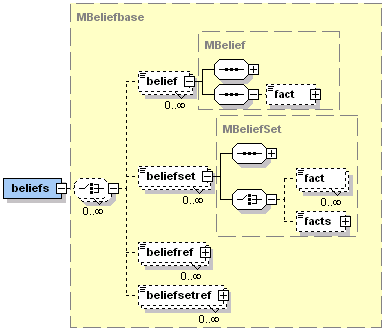Beliefs represent the agent's knowledge about its enviroment and itself. In Jadex the beliefs can be any Java objects. They are stored in a belief base and can be referenced in expressions, as well as accessed and modified from plans using the beliefbase interface.
The beliefbase is the container for the facts known by the agent.
Beliefs are usually defined in the ADF and accessed and modified from plans. To define a
single valued belief or a multi-valued belief set in the ADF the developer has
to use the corresponding <belief>
or <beliefset> tags (Figure 6.1, “The Jadex beliefs XML schema part”)
and has to provide a name and a class. The name is used to refer to the fact(s)
contained in the belief. The class specifies the (super) class of the fact objects
that can be stored in the belief. The default fact(s) of a belief may be supplied
in enclosed <fact> tags.
Alternatively, for belief sets a collection of initial facts can be directly
specified using a <facts> tag.
This is useful, when you do not know the number of initial facts in advanvce, e.g.,
when invoking a static method or retrieving values from a database
(see Figure 6.2, “Example belief definition”). References to beliefs and belief sets
from inner capabilities can be defined using the <beliefref>
and <beliefsetref> tags (cf.
Section 5.3, “Elements of a Capability”).
<agent ...>
...
<beliefs>
<belief name="my_location" class="Location">
<fact>new Location("Hamburg")</fact>
</belief>
<beliefset name="my_friends" class="String">
<fact>"Alex"</fact>
<fact>"Blandi"</fact>
<fact>"Charlie"</fact>
</beliefset>
<beliefset name="my_opponents" class="String">
<facts>Database.getOpponents()</facts>
</beliefset>
...
</beliefs>
...
</agent>Figure 6.2. Example belief definition
From within a plan, the programmer has access to the beliefbase (class
IBeliefbase) using the getBeliefbase() method.
The beliefbase provides getBelief() / getBeliefSet()
methods to get the current beliefs and belief sets by name, as well as methods
to create new beliefs and belief sets or remove old ones. The content of a belief
(class IBelief) can be accessed by the getFact() method.
A belief set (class IBeliefSet) is accessed through the
getFacts() method and will return an appropriately typed array of facts.
To check if a fact is contained in a belief set the containsFact()
method can be used.
The contents of a single fact belief are modified using the
setFact() method.
Setting a fact on a belief will result in overwriting the previous value, if any.
For deleting the fact of a single fact belief, you can set the belief value to
null. Belief sets are manipulated using the
addFact(fact) / removeFact(fact) methods.
When removing facts that do not exist from the belief set, the belief set remains
unchanged and a warning message will be produced. For the remove operation,
the beliefbase relies on the implementation of the equals()
method of the fact objects. Additionally, updateFact(fact) can
be used to replace an existing fact value.
In the ADF the initial facts of beliefs are specified using expressions.
Normally, the fact expressions are evaluated only once: When the agent is born.
The evaluation behavior of the fact expression can be adjusted using the
evaluationmode
attribute as further described in
Section 10.2, “Expression Properties”. Additionally, an
updaterate may be specified
as attribute of the belief that will cause the fact to be continuously evaluated
and updated in the given time interval (in milliseconds).
In the example, the first belief
"time" is evaluated on access,
and will therefore always contain the exact current time as returned by the Java function
System.currentTimeMillis(). The second belief
"timer"
is not only evaluated on access (i.e., when accessed), but also every 10 seconds (10000 milliseconds).
The advantage of using an updaterate for continuously evaluating a belief is
that the fact value changes even when it is not accessed, and therefore may trigger
conditions referring to that belief. For example, using the
"timer"
belief you could define a condition to invoke a plan that has to be executed
in continuous intervals.
Both options also provide an easy and effective way for making an agent aware
of external input (e.g., sensory data available through a Java API).
<beliefs>
<!-- A belief holding the current time (re-evaluated on every access). -->
<belief name="time" class="long">
<fact evaluationmode="dynamic">
System.currentTimeMillis()
</fact>
</belief>
<!-- A belief continuously updated every 10 seconds. -->
<belief name="timer" class="long" updaterate="10000">
<fact> System.currentTimeMillis() </fact>
</belief>
</beliefs>Figure 6.4. Examples of dynamically evaluated beliefs
To monitor conditions (cf. Chapter 11, Conditions), an agent observes the beliefs and automatically reacts to changes of these beliefs, as necessary. Jadex is aware of manipulation operations that are executed directly on beliefs, e.g., by setting the fact of a belief, and of changes due to belief dependencies (i.e., a dynamically evaluated fact expression referencing another belief).
On the other hand, when you retrieve a complex fact object from a belief or belief set and perform
operations on it subsequently, the system cannot detect the changes made.
To enable the system detecting these changes the standard Java beans event
notification mechanism can be used. This means that the bean has to implement the
add/removePropertyChangeListener() methods and
has to fire property change events, whenever an important change has occurred.
The belief will automatically add and remove itself as a property change listener on
its facts. An example how to implement this functionality inside a Java bean
is shown below.
import java.beans.PropertyChangeSupport;
import java.beans.PropertyChangeListener;
public class Location {
private int x, y;
private PropertyChangeSupport pcs;
public Location(int x, int y) {
this.x = x;
this.y = y;
this.pcs = new PropertyChangeSupport(this);
}
public int getX() {
return this.x;
}
public void setX(int x) {
int old = this.x;
this.x = x;
this.pcs.firePropertyChange("X", old, this.x);
}
public int getY() {
return this.y;
}
public void setY(int y) {
int old = this.y;
this.y = y;
this.pcs.firePropertyChange("Y", old, this.y);
}
public void addPropertyChangeListener(PropertyChangeListener listener) {
pcs.addPropertyChangeListener(listener);
}
public void removePropertyChangeListener(PropertyChangeListener listener) {
pcs.removePropertyChangeListener(listener);
}
}
